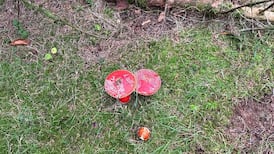At the bend in the road at the top of the hill the summer tourists tread hard on the brakes, not so much for caution as in sudden awe of the view. It is partly the grand spread of it all – so much landscape at once – but partly its near-primitive disposition.
There’s the size of the strand, for a start, sprawling back around the dunes to a big lawn of level, grassy machair; then the channel of the mountain river, winding through the sand. This curls back to a couple of lakes or lagoons, one glittering under a low, wooded cliff with a plateau of bog beyond. All this is virtually roadless and couched below the mountains as if for revelation: Mweelrea on this side, lofty Benwhatsit across in Connemara. The mouth of the fjord, Killary Harbour, opens darkly in between.
The soft bits of Thallabawn are distinctly dynamic, their sculpting and shifting over the centuries ruled by wind and wave. A map from 1838 shows dunes at either end of the strand but great tongues of bare sand licking far back into the shore. By 1919 the dunes had grown across from the south, and the machair and lakes were forming behind them. But the little graveyard perched on the northern dunes was now an isolated pyramid in the sand.
This “burial mound”, as everyone knew it, has since been melted by storms into a flat mandala of stone slabs. The dunes have been trimmed back and cliffed on the seaward side. A new rampart of rocks has been built to resist the flood when spring tide and swollen river combine to attack the lowest, sandy pastures. A farmer tried to persuade the channel to take a more direct course to the sea – he took his digger to the strand and carved a new course for it, straight out. The tides erased it, and the channel resumed its leisurely loop of an estuary: it is where it wants to go.
So, even without global warming, this soft stretch of the west has known enormous change, as storms, tides and currents have played with available sediments – offshore sand and gravel swept out in the melt of the glaciers or carried down in the river from the mountain. A summer as calm as the last one let the waves build up the strand – a new soft and fluffy selvedge at the edge. The autumn gales have been clawing the sand back again, the breakers spinning like wheels.
Looking out from my my desk I wonder, of course, how far fiercer and steeper storm-piled waves will bring a rising sea. Round and over the dunes, I suppose, into the lakes, and as far as the reedy marsh where the hillside rock begins to rise. I shan’t see it, but somebody will.
With Ireland taking much of the brunt of Europe's future Atlantic storms, our coastline has been under close study since the late 1970s. Ireland's leading authority on likely sea-level impact is Dr Robert Devoy, professor of geography at University College Cork's Coastal and Marine Research Centre. For the immediate future, his work is relatively reassuring. Much of our coast, as he describes, already has high resilience, conditioned to environmental extremes of big tides, frequent storms and heavy rainfall. Our western continental shelf, the inshore shallows that run into rocky platforms, and our wide and often island-studded bays all help to blunt and dissipate the power of hurricane-heaped Atlantic swells and slow initial erosion from a rising sea level. Even so, about a third of coastal wetlands like the one below me seem doomed to disappear.
Erosion already bites hardest at the soft cliffs of glacial till at the southeast corner of the island, averaging as much as a metre a year. But the south and east coasts at least have an abundant supply of sediment for the beaches, lying in banks offshore. Elsewhere, the supply from these old glacial deposits has almost ceased. Instead, sand and gravel in beach barriers is being swept along the shore and dissipated, and tractorloads scooped up for construction have robbed the budget further.
How fast will the sea level rise? A survey of 90 sea-level experts in 18 countries, just published (go to realclimate.org) offers a consensus of 40-60cm in this century if the human world takes determined action to limit carbon dioxide and 70-120cm if it does not. Devoy, like all his colleagues, wrestles with the uncertainties of modelling, melting ice, and political commitment. The latest conference fiasco in Poland will not have encouraged him.
He does, however, think it's time – long, long past time – we prepared for it. Integrated coastal zone management, well discussed through the 1990s and strongly urged by Europe, would bang heads together in the several Government departments concerned, and involve coastal communities as stakeholders. UCC's website on the subject, however, has found nothing new to say since 2004.
I think, while there’s time, I must walk to the far lake and listen to the whooper swans gossiping under the cliff.










